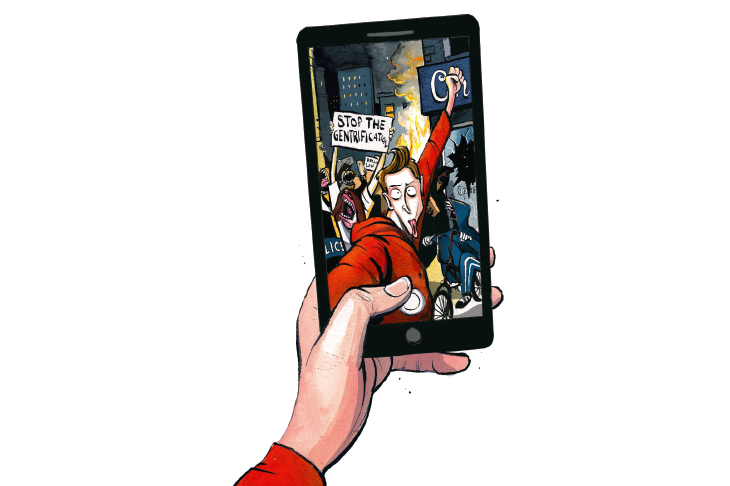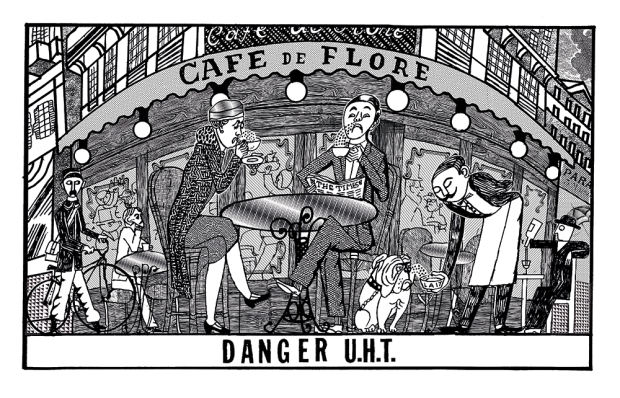Last weekend, I got into a conversation with the son of an old friend. He’s a nice middle-class boy, mid-twenties, who plays in a band and has lots of tats and piercings. We got into a conversation about summer festivals. I was telling him about a wonderful one I’d been to — the Curious Arts Festival — and then I asked him, ‘You been to anything exciting?’ ‘Yeah,’ he said with a grin, ‘I went to a riot in east London.’
The riot, I discovered, had been a protest for Rashan Charles, a 20-year-old black man from east London who died after being chased and apprehended by a police officer in Dalston. It was a horrible death, the circumstances of which are still being investigated. His family appealed for calm, but that did not put off the protesters who saw an opportunity. Wheelie bins were used as barricades and then set alight; fireworks were launched towards police. It was clearly an ugly and scary scene.
What was interesting was that the young man I spoke to made it sound like the social event of the season. He waxed lyrical about the ‘energy’, ‘excitement’ and ‘buzz’ of the event, as if it had been Glastonbury or a great rock gig. This young man is a casualty of what can be called riot chic: the fashionable belief that political violence is a legitimate and necessary form of social protest. And kind of fun and cool too.
Riot chic is a global phenomenon, which is funny seeing as most of it is directed against globalisation. It can be seen in the anti-Trump movement in America, which has often turned violent, as well as the Black Lives Matter protests, which started off as anger at police violence but which have resulted in fights and vandalism across America. It can be seen in the ‘Welcome to Hell’ anti-capitalist protests at the G20 summit in Hamburg last month, which injured almost 500 police officers and led to 186 arrests. Observers described the atmosphere as being similar to a rave.
The riot chic crowd seek the euphoric rush that comes from combining violence with the feeling that you’re being virtuous. After all, you’re barbecuing someone’s car or throwing a bottle in the name of social justice! If you get clobbered by a police truncheon, well, nothing says you care about inequality like a fat lip from the old bill. Even if you don’t want to be involved in the violence, you can have the pleasure of being near the action, and of filming it on your phone to share on social media.
I know the thrill of a riot because in the 1960s I went to an anti-Vietnam war demo outside the American embassy and saw the buzz as people threw marbles under the feet of the police horses. I was so scared I ditched my ‘Save North Vietnam’ placard and went home. But it was exciting.
Like any other human activity, political activism is subject to the whims of fashion. After the mid-1970s, riots largely went out of vogue. In 2008, the old revolutionary Tariq Ali wrote a famous essay that asked ‘Where has all the rage gone?’
Well, it came back. Rage is all the rage. It’s there in the protests at the death of Rashan Charles. It was there in the Grenfell Tower protests, which started off as justified resident outrage but were soon hijacked by social justice warriors and middle-class thrill seekers who moved the march on to Downing Street.
It’s no accident that riot chic has emerged at a time when we have a far-left Labour party led by people who can’t bring themselves to condemn the IRA. John McDonnell, the shadow chancellor, holds a sentimental view of violent street protests. He hailed the student protests of 2010 as ‘the best of our movement’. He was talking about a protest which involved fires being lit, the Cenotaph disrespected, and a fire extinguisher dropped from the top of Millbank Tower. Yet to McDonnell, this showed ‘what there was out there in terms of resources … the students kicking the shit out of Millbank, and then that spark, lighting all the combustible material, that then brought people out.’
People like McDonnell consider aggressive street protests to be a legitimate mode of political expression — except when they don’t approve of the protesters’ motives. (It’s interesting that neither Jeremy Corbyn nor McDonnell has said anything about the huge riots taking place in Venezuela this week, possibly because they have themselves been supporters of the corrupt leftist Maduro regime against which the protests are directed.)
You are unlikely to hear a Corbyn-ista come out and bluntly say it the way the future Labour MP Bernie Grant did in 1985, when, following the riots at Broadwater Farm in Tottenham and the murder of PC Keith Blakelock, he boasted that ‘the police got a good hiding’. Today, the left won’t overtly condone violent protests — but they won’t condemn them with much force either. Diane Abbott appeared at a Black Lives Matter protest outside Stoke Newington police station and declared that ‘Violence is not the answer.’ Note that she didn’t say violence is wrong or hurtful to the cause. It is easy to condemn the alleged violence of the police — why is it so hard when it comes to protesters?
Today you can hear the sound of riot chic in the words of pop stars, rappers, pundits and politicians, who queue up to offer knee-jerk anti-police or anti-government reactions after any tragedy. The rapper and journalist Franklyn Addo, from Hackney, says that we must not call the Rashan protests riots because that’s a way of vilifying them — but he ignores the fact that the kids taking part in the protests talk approvingly about rioting online, using hashtags like ‘revolution’, ‘wewontbackdown’ and ‘wedontplaythatshit’ under pictures of stuff on fire. ‘Justice is an outcome that legal systems cannot guarantee,’ Franklyn says, by way of explanation.
We don’t yet know exactly what happened to Rashan Charles, and neither does Franklyn, so any talk of justice is cant. But it’s important to keep expressing outrage — even when you don’t know the facts.
Riot chic isn’t interested in facts or justice, or what we used to call the truth. It’s the way things look immediately, the pose, how a certain image of police brutality or capitalist cruelty becomes an excuse to rage, riot and come out with absurd rants.
Like the proclamations from Jason Osamede Okundaye, the current king of riot chic. Okundaye, who runs Cambridge University’s Black and Minority Ethnic Society, took to Twitter after the protests over Rashan Charles to declare his full support for the rioters, advising them to ‘smash every-thing’, and claiming that ‘all white people are racist’.
‘Watching these middle-class white people despair over black people protesting in their colonised Dalston is absolutely delicious,’ said this 20-year-old ex-public schoolboy whose mother works in the civil service. Absolutely delicious? He sounds like a literary snob enjoying a particularly bitchy book launch. Only a middle-class person would use ‘delicious’ in that context.
But then riot chic is all about the middle classes expressing their own self-hatred. It is prevalent among the white people who offered Okundaye this ‘delicious’ spectacle. They loathe belonging to what they see as the bland bourgeoisie. They hate the urban gentrification that they are part of, which partly explains why so many middle-class voters in west London voted for Labour’s Emma Dent Coad, Kensington’s new MP, who promises to fight ‘gentrification one cupcake at a time’.
Riot chic is, like cupcakes, an import of American culture — the Black Lives Matter and Occupy movements both began in the post-crash US. Studies have shown that almost all those arrested in the Occupy Wall Street protests came from areas where the value of houses was more than double the national average. No doubt that has something to do with the fact that travelling to take part in protests can be time-consuming and expensive, and only people with money can afford to do it. In some parts of America, protesting has actually become quite an effective high-status signifier; radicals wear T-shirts declaring that ‘Protest is the new brunch’, and try not to choke on the irony. In Britain, the trend hasn’t quite reached that stage, but raging against the machine is undeniably an activity for the affluent young, as well as for useful lower-class gang members who just want to smash things up. The more edgy or dangerous a protest is, the more authentic it feels.
You might want to point out that rioting never achieves anything much. As Robert Kennedy once put it, ‘No wrongs have ever been righted by riots and civil disorders.’ That’s to miss the point. Today’s political violence isn’t about social change or the demand for justice — it’s about self-expression. It’s a form of therapy; it is the triumph of me politics — my feelings, my need to express myself.
To even question the validity of aggressive street protests now is to risk being branded some sort of right-wing, police–loving apologist who doesn’t care about the lives of black people. But there’s a good progressive case against the whole idea and practice of riots. It is an attack on democracy and on the right of every citizen to be able to demonstrate without the fear of mob violence.
Anybody who isn’t prepared to distance themselves from rioters should take a tip from Rashan Charles’s family. Pauline Pearce, a friend of the Charles family, said in a statement: ‘The parents, the family, have requested we keep calm. There are many organisations out there that are jumping on the bandwagon, running and organising these police protests at the station. This is nothing to do with the family, it has no authorisation from the family.’
If only our politicians and the riot chic crowd were equally brave and unequivocal.
Got something to add? Join the discussion and comment below.
Get 10 issues for just $10
Subscribe to The Spectator Australia today for the next 10 magazine issues, plus full online access, for just $10.
You might disagree with half of it, but you’ll enjoy reading all of it. Try your first month for free, then just $2 a week for the remainder of your first year.














Comments
Don't miss out
Join the conversation with other Spectator Australia readers. Subscribe to leave a comment.
SUBSCRIBEAlready a subscriber? Log in